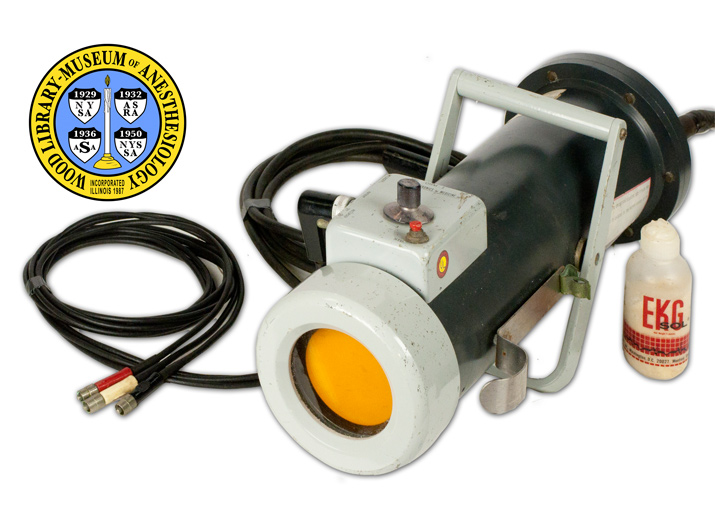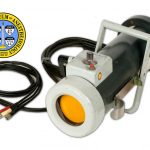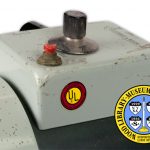Operating Room Monitor, ORM-1
The ORM-1 Operating Room Monitor, also called a “Bullet” oscilloscope, was one of the first devices that enabled anesthesiologists to continuously monitor their patients' electrocardiograms (ECGs) during surgery. An ECG displays the electrical activity of the heart. Earlier oscilloscopes used cathode ray tubes, which produced an electron beam, to display the electrical signals from the heart. Flammable anesthetic gases in the presence of cathode ray tubes were too serious a fire hazard to be used in the operating room. Once manufacturers developed 'explosion proof’ oscilloscopes, around 1960, they were eagerly adopted by anesthesiologists.
Numerous conditions can affect the electrical function of the heart, so monitoring a patient’s ECGs during surgery is important. But this is only one parameter among many that anesthesiologists closely monitor. Anesthesiologists take in many streams of information from the patient, the monitoring tools, the anesthetic equipment, the surgical team and more. This information is constantly interpreted into a meaningful picture that allows them to make decisions and take action quickly. Monitoring the patient and all of the elements that impact the patient is not just about preventing and responding to complications but optimizing the patient’s condition before, during and after surgery. The motto of the American Society of Anesthesiologists is "Vigilance."
Catalog Record: Operating Room Monitor, ORM-1
Access Key: aipi
Accession No.: 2010-07-28-1
Title: ORM-1 : operating room monitor / Electronics for Medicine.
Corporate Author: Electronics for Medicine, Inc.
Title variation: Alt Title
Title: Electronics for Medicine ORM1 oscilloscope on pole stand.
Title variation: Alt Title
Title: E4M bullet oscilloscope.
Title variation: Alt Title
Title: Electrocardioscope.
Publisher: White Plains, N.Y. : Electronics for Medicine, Inc., [1960-1979].
Physical Description: 1 monitoring device : metals, plastic, glass, paint : 19 x 15 x 58 cm. + 2 cables/cords and stand.
Subject: Electrocardiography.
Subject: Monitoring, Intraoperative.
Subject: Monitoring, Physiologic.
Subject: Oscillometry.
Subject: Electroencephalography.
Note Type: General
Notes: Title from manufacturer’s markings; Alternate titles from the WLM accession
record.
Note Type: With
Notes: With a metal stand approx. 108 x 44 x 44 cm in size, and a plastic bottle of
conduction gel approx. 12 x 5 cm dia.; The gel is “EKG SOL” made by Burton,
Parsons & Company, Inc. of Washington, D.C. and Montreal, Canada.
Note Type: Citation
Notes: Burch GE, DePasquale NP. A History of Electrocardiography. Chicago: Year Book
Medical Publishers, 1964.
Note Type: Citation
Notes: Price List : United States, Canada and Mexico. White Plains, N.Y.:
Electronics for Medicine, Inc, 1962.
Note Type: Physical Description
Notes: The oscilloscope is cylindrical with an orange colored screen at one end and
a power-cord at the other; Above the port for the power-cord is a metal plate
with manufacturer’s markings: “MODEL ORM-1 [new line] OPERATING ROOM MONITOR
[new line] ELECTRONICS FOR MEDICINE, INC. [new line] WHITE PLAINS, N.Y. [new
line] 120 VOLTS 50/60 CYCLES [new line] 27 WATTS SERIAL NO. 2191 [new
line] WARNING [new line] UNIT MUST BE DISCONNECTED FROM POWER LINE BEFORE
CASE IS OPENED [new line] CLASS I GROUP C [new line] CSA LISTING No. 2087
[new line] MADE IN U.S.A.”; The controls are on a rectangular ‘box’ near the
screen-end of the oscilloscope; A rotating knob (lead-selector) can be turned
to point at one of 4 markings: “1”, “2”, “3” or “EEG”; A red push-button is
marked, “STD.”; There are two output-ports on one side of the control-box are
marked, “RECORD” AND “PATIENT”; A toggle switch is marked, “RECORDER [new
line] ON [spaces] OFF”; A maintenance sticker is marked with “KAMED, Columbus
Ohio” and indicates that maintenance was performed on the following dates:
4-23-1979 and 4/28/1981; The cord or cable for the leads is attached to the
plug labeled “PATIENT”; The lead cable splits into three cables that end in a
color: one is white at the end, one is red, and one black; The lead cable is
approx. 486 cm in length; The power-cord measures approx. 564 cm in length; A
metal clasp on one side of the oscilloscope holds a bottle of conduction-gel
on the instrument.
Note Type: Reproduction
Notes: Photographed by Mr. William Lyle, July 28, 2010; Photographed with an
accompanying bottle of “EKG SOL” conduction gel.
Note Type: Historical
Notes: Electronics for Medicine marketed the ORM-1 as the first oscilloscope made
specifically for the operating room. A 1962 Electronics for Medicine
price-list lists the ORM-1 for 645.00 dollars. Cathode-ray oscilloscopes were
first introduced in 1936 and 1937 by three independent researchers, Fritz
Schellong (1891-1953) of Germany, and H.E. Hollmann with W. Hollmann, both of
Germany, and Frank Norman Wilson (1890-1952) of the US (Burch & DePasquale,
1964). Before the development of ‘explosion proof’ oscilloscopes, or
cardioscopes, like the the ORM-1, anesthesiologists were unable to
continuously monitor their patients’ electrocardiograms (ECGs) during surgery
Note Type: Historical
Notes: Although our records do not indicate that cardioscopes were used to monitor
patients’ electroencephalograms (EEGs) in clinical practice, this apparatus
does provide the option, and other makers of cardioscopes marketed their
devices as being able to display either ECGs or EEGs.



